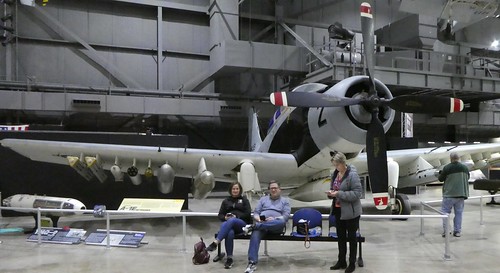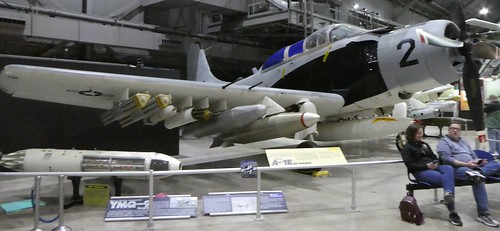The Southeast Asia War Gallery in the National Museum of the United States Air Force in Dayton, Ohio includes several air support aircraft.
With regard to the Southeast Asia War:
A product of the Cold War, the Southeast Asia War (1961-1973) began with communist attempts to overthrow non-communist governments in the region. United States participation in the Southeast Asia War resulted from the policy of "containment," which aimed to prevent communism from expanding beyond its early Cold War borders. The containment strategy seldom led to major combat, but as with the Korean War (1950-1953), the US committed large military forces to protect an allied, non-communist government.
The main U.S. goal in the Southeast Asia War was to protect South Vietnam -- initially from a local communist insurgency and later from conquest by communist North Vietnam. The U.S. also hoped to prevent the spread of communism to other nearby countries. Although popularly known as the Vietnam War, U.S. efforts included military action not only in South and North Vietnam, but also in neighboring Southeast Asian countries.
Douglas A-1 Skyraider
According to the Museum:
The Douglas A-1 Skyraider played an important part in the Southeast Asia War. Its ability to carry an immense amount of weapons and stay over the battlefield for extended periods of time made it a powerful weapon. This aircraft provided close air support to ground forces, attacked enemy supply lines, and protected helicopters rescuing airmen downed in enemy territory.
Designed during World War II for the U.S. Navy, the Skyraiders almost disappeared before they had the opportunity to excel over Southeast Asia. In the high-speed, jet-age world of the late 1950s, the Skyraider seemed to be a relic of an earlier time. It had performed well during the Korean War, but the Navy had decided to replace it with jet aircraft. However, Skyraiders proved well suited for fighting against the guerrilla-style war waged by communists in Southeast Asia.
The first U.S. Air Force Skyraiders, two-seat A-1Es, arrived at Bien Hoa Air Base in May 1964. They were assigned to the 1st Air Commando Squadron (later the 1st Special Operations Squadron), which operated under the call sign Hobo. Other USAF squadrons flew Skyraiders from bases in South Vietnam and Thailand under the call signs Spad, Firefly and Zorro. Wherever they went, the Skyraiders provided critical close air support to ground forces and other operations, such as defoliant spraying or supporting the insertion and extraction of special operations teams inside enemy held territory along the Ho Chi Minh Trail.
This aircraft has a top speed of 325 mph, and a range of 1,500 miles. It carried a wide assortment of bombs, rockets, mines, grenades, flares and gun pods.




Cessna A-37 Dragonfly
According to the Museum:
From 1964-1966, the U.S. Air Force evaluated two modified T-37 trainers, designated YAT-37Ds, as prototypes for a counter-insurgency (COIN) attack/reconnaissance aircraft to use in Southeast Asia. Following this evaluation, the USAF contracted Cessna to modify 39 T-37Bs into A-37As in 1967. Later that year, the USAF sent 25 A-37As, nicknamed "Super Tweets," to Southeast Asia for combat evaluation under the name Combat Dragon. These aircraft primarily flew close air support, night interdiction and forward air control missions in South Vietnam and southern Laos.
Based on the successful results of Combat Dragon, the USAF order newly built A-37Bs, which had cockpit armor, more powerful engines, redundant flight controls, provision for aerial refueling and a strengthened airframe. Of the 577 A-37Bs built, the USAF provided 254 to the South Vietnamese Air Force (VNAF) to replace their aging A-1 Skyraiders. Although the A-37B served with the USAF for only a short period, a number of A-37Bs remained in use with the Air Force Reserve and Air National Guard as observation/flight attack aircraft until the last one was retired in 1992.
This aircraft has a top speed of 485 mph, a cruising speed of 425, a range of 270 miles, and a ceiling of 36,000 feet. It carried 3,000 pounds of bombs, rockets and/or missiles.



Ling-Temco-Vought (LTV) A-7D Corsair II
According to the Museum:
The A-7D is a single-seat, tactical close air support aircraft derived from the U.S. Navy's A-7. The first A-7D made its initial flight in April 1968, and deliveries of production models began in December 1968. When A-7D production ended in 1976, LTV had delivered 459 to the U.S. Air Force.
The A-7D demonstrated its outstanding ground attack capability flying with the 354th Tactical Fighter Wing at Korat Royal Thai Air Force Base, Thailand, during the closing months of the Southeast Asia War. The Corsair II achieved its excellent accuracy with the aid of an automatic electronic navigation and weapons delivery system. Although designed primarily as a ground attack aircraft, it also had limited air-to-air combat capability.
In 1973 the USAF began assigning A-7Ds to the Air National Guard (ANG), and by 1987 they were being flown by ANG units in 10 states and Puerto Rico. A-7Ds participated in Operation Just Cause in Panama in 1989. The last A-7Ds were retired in the early 1990s.
This aircraft has a top speed of 663 mph, a cruising speed of 545, a range of 3,044 miles, and a ceiling of 33,500 feet. It carried 15,000 pounds of mixed ordnance.





More Air Force Museum exhibits
Air Force Museum: Southeast Asia cargo aircraft (photo diary)
Air Force Museum: Cold War bombers (photo diary)
Air Force Museum: Cold War Boeing airplanes (photo diary)
Air Force Museum: Some experimental aircraft (photo diary)
Air Force Museum: Vertical takeoff aircraft (photo diary)
Air Force Museum: Space Gallery Aircraft (photo diary)
Air Force Museum: Experimental unmanned aircraft (photo diary)
Air Force Museum: MiGs (photo diary)


